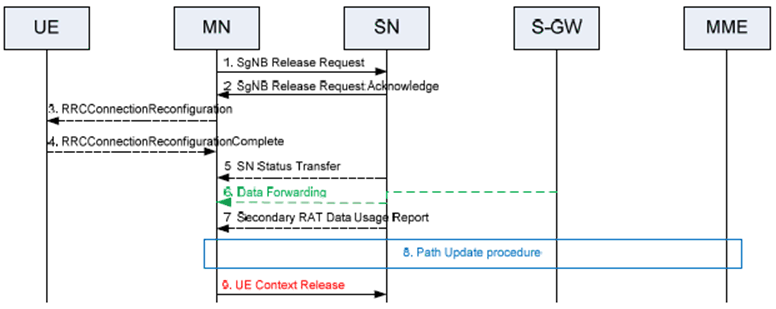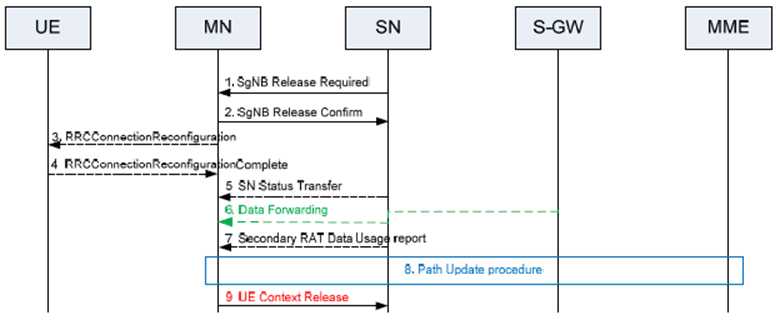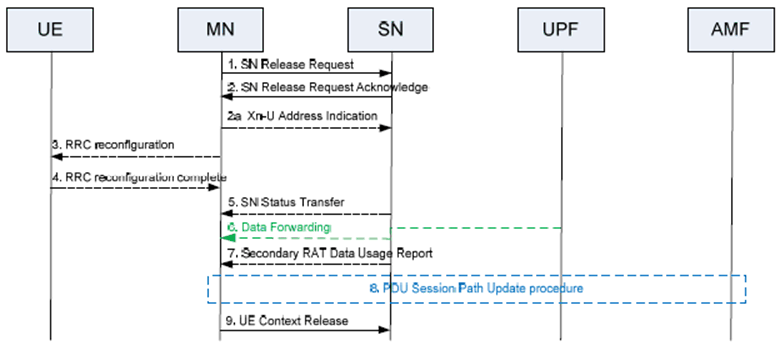Content for TS 37.340 Word version: 18.2.0
1…
4…
4.2…
4.3…
5…
7…
8…
9
10…
10.2…
10.2.2…
10.3…
10.3.2
10.4…
10.5…
10.5.2
10.6
10.7…
10.8…
10.9…
10.10…
10.11…
10.12…
10.12.2
10.13…
10.14…
10.15
10.16…
10.17…
10.18…
10.19…
10.20
11…
A
B…
10.4 Secondary Node Release (MN/SN initiated) p. 54
10.4.1 EN-DC p. 54
The Secondary Node Release procedure may be initiated either by the MN or by the SN and is used to initiate the release of the UE context at the SN. The recipient node of this request can reject it, e.g., if a SN change procedure is triggered by the SN.
In case of CPA or inter-SN CPC, this procedure may be initiated either by the MN or the candidate SN, and it is used to cancel all the prepared PSCells at the candidate SN and initiate the release of related UE context at the candidate SN.
It does not necessarily need to involve signalling towards the UE, e.g., in case of the RRC connection re-establishment due to Radio Link Failure in MN.
MN initiated SN Release

Figure 10.4.1-1 shows an example signalling flow for the MN initiated Secondary Node Release procedure when SN Release is confirmed by SN.
Step 1.
SN initiated SN Release
The MN initiates the procedure by sending the SgNB Release Request message. If applicable, the MN provides data forwarding addresses to the SN.
Step 2.
The SN confirms SN Release by sending the SgNB Release Request Acknowledge message. If appropriate, the SN may reject SN Release, e.g. if the SN change procedure is triggered by the SN.
Step 3/4.
If required, the MN indicates in the RRCConnectionReconfiguration message towards the UE that the UE shall release the entire SCG configuration. In case the UE is unable to comply with (part of) the configuration included in the RRCConnectionReconfiguration message, it performs the reconfiguration failure procedure.
Step 5.
For bearers using RLC AM, the SN sends the SN Status Transfer message.
Step 6.
Data forwarding from the SN to the MN may start.
Step 7.
The SN sends the Secondary RAT Data Usage Report message to the MN and includes the data volumes delivered to and received from the UE over the NR radio for the related E-RABs.
Step 8.
If applicable, the path update procedure is initiated.
Step 9.
Upon reception of the UE Context Release message, the SN releases radio and C-plane related resources associated to the UE context. Any ongoing data forwarding may continue.

Figure 10.4.1-2 shows an example signalling flow for the SN initiated Secondary Node Release procedure.
Step 1.
The SN initiates the procedure by sending the SgNB Release Required message which may contain inter-node message to support delta configuration.
Step 2.
If applicable, the MN provides data forwarding addresses to the SN in the SgNB Release Confirm message. The SN may start data forwarding and stop providing user data to the UE as early as it receives the SgNB Release Confirm message.
Step 3/4.
If required, the MN indicates in the RRCConnectionReconfiguration message towards the UE that the UE shall release the entire SCG configuration. In case the UE is unable to comply with (part of) the configuration included in the RRCConnectionReconfiguration message, it performs the reconfiguration failure procedure.
Step 5.
For bearers using RLC AM, the SN sends the SN Status Transfer message.
Step 6.
Data forwarding from the SN to the MN may start.
Step 7.
The SN sends the Secondary RAT Data Usage Report message to the MN and includes the data volumes delivered to and received from the UE over the NR radio for the related E-RABs.
Step 8.
If applicable, the path update procedure is initiated.
Step 9.
Upon reception of the UE Context Release message, the SN releases radio and C-plane related resources associated to the UE context. Any ongoing data forwarding may continue.
10.4.2 MR-DC with 5GC p. 56
The SN Release procedure may be initiated either by the MN or by the SN and is used to initiate the release of the UE context and relevant resources at the SN. The recipient node of this request can reject it, e.g., if an SN change procedure is triggered by the SN.
In case of CPA, inter-SN CPC or inter-SN subsequent CPAC, this procedure may be initiated either by the MN or the candidate SN, and it is used to cancel all the prepared PSCells at the candidate SN and initiate the release of related UE context at the candidate SN.
MN initiated SN Release

Figure 10.4.2-1 shows an example signalling flow for the MN initiated SN Release procedure.
Step 1.
SN initiated SN Release
The MN initiates the procedure by sending the SN Release Request message.
Step 2.
The SN confirms SN Release by sending the SN Release Request Acknowledge message. If appropriate, the SN may reject SN Release, e.g., if the SN change procedure is triggered by the SN.
Step 2a.
When applicable, the MN provides forwarding address information to the SN.
Step 3/4.
If required, the MN indicates in the MN RRC reconfiguration message towards the UE that the UE shall release the entire SCG configuration. In case the UE is unable to comply with (part of) the configuration included in the MN RRC reconfiguration message, it performs the reconfiguration failure procedure.
Step 5.
If PDCP termination point is changed to the MN for bearers using RLC AM, the SN sends the SN Status Transfer message.
Step 6.
Data forwarding from the SN to the MN may start.
Step 7.
The SN sends the Secondary RAT Data Usage Report message to the MN and includes the data volumes delivered to and received from the UE as described in clause 10.11.2.
Step 8.
If applicable, the PDU Session path update procedure is initiated.
Step 9.
Upon reception of the UE Context Release message, the SN releases radio and C-plane related resources associated to the UE context. Any ongoing data forwarding may continue.

Figure 10.4.2-2 shows an example signalling flow for the SN initiated SN Release procedure.
Step 1.
The SN initiates the procedure by sending the SN Release Required message which may contain inter-node message to support delta configuration.
Step 2.
If data forwarding is requested, the MN provides data forwarding addresses to the SN in the SN Release Confirm message. The SN may start data forwarding and stop providing user data to the UE as early as it receives the SN Release Confirm message.
Step 3/4.
If required, the MN indicates in the MN RRC reconfiguration message towards the UE that the UE shall release the entire SCG configuration. In case the UE is unable to comply with (part of) the configuration included in the MN RRC reconfiguration message, it performs the reconfiguration failure procedure.
Step 5.
If PDCP termination point is changed to the MN for bearers using RLC AM, the SN sends the SN Status Transfer message.
Step 6.
Data forwarding from the SN to the MN may start.
Step 7.
The SN sends the Secondary RAT Data Usage Report message to the MN and includes the data volumes delivered to and received from the UE as described in clause 10.11.2.
Step 8.
If applicable, the PDU Session path update procedure is initiated.
Step 9.
Upon reception of the UE Context Release message, the SN releases radio and C-plane related resources associated to the UE context. Any ongoing data forwarding may continue.